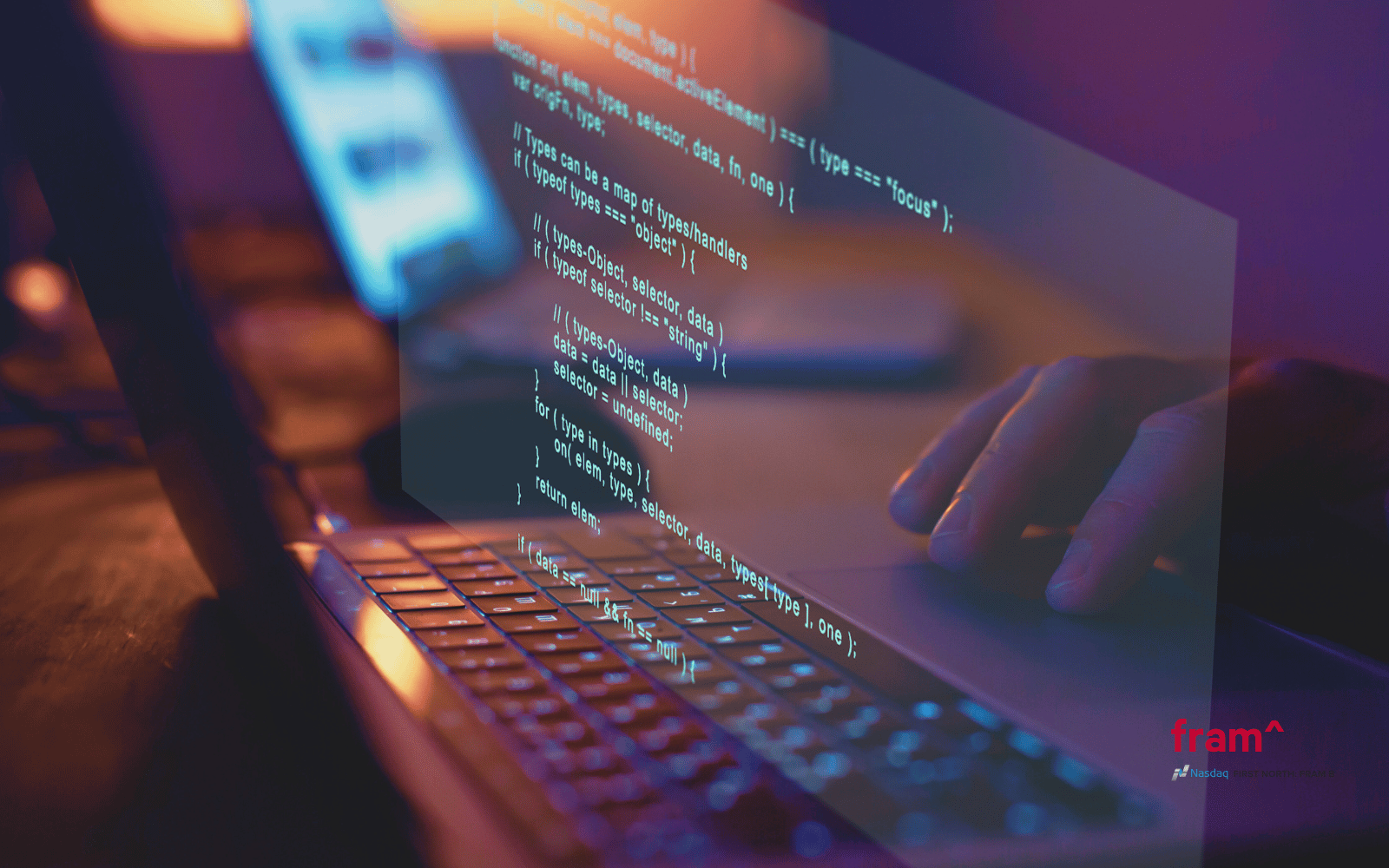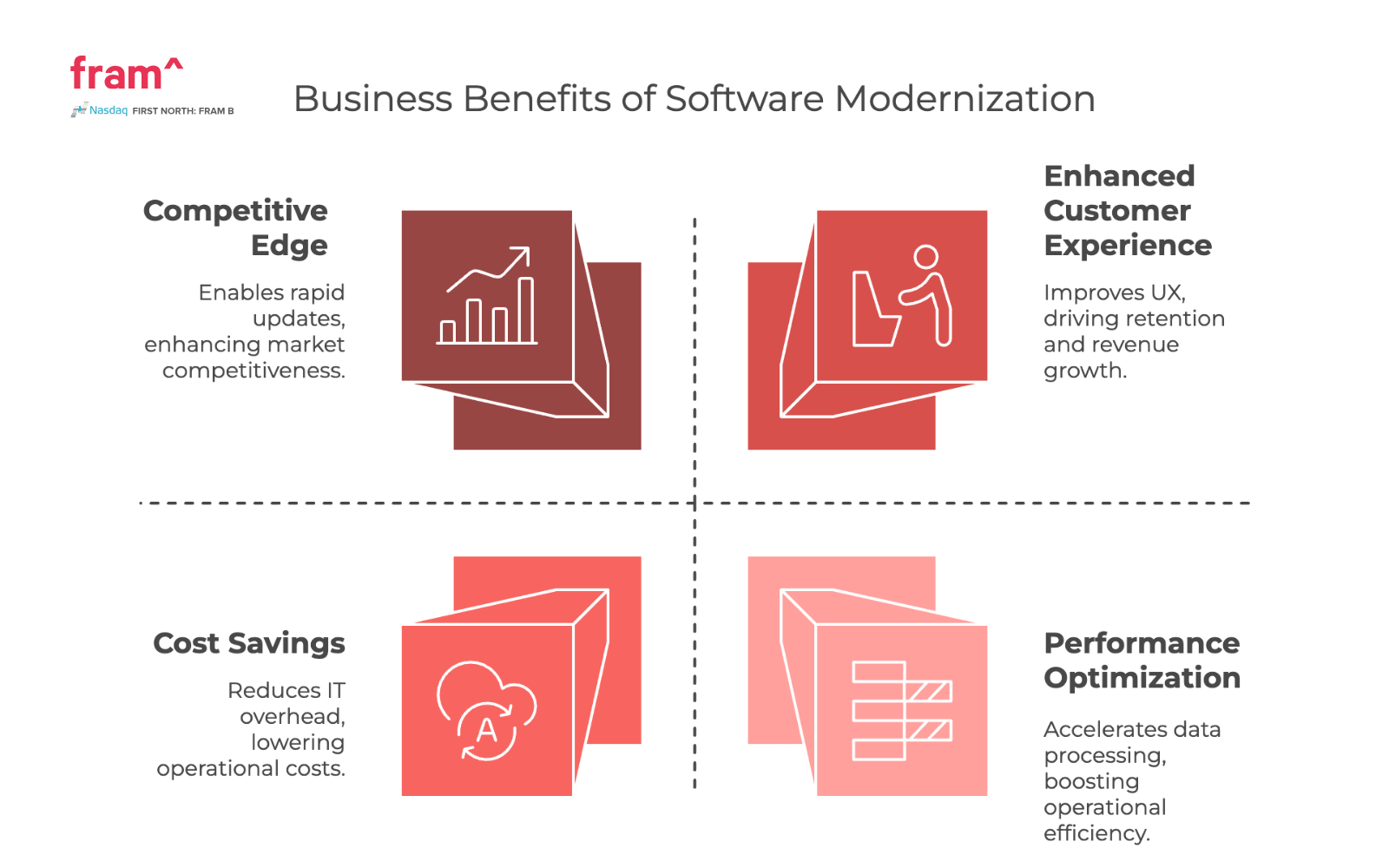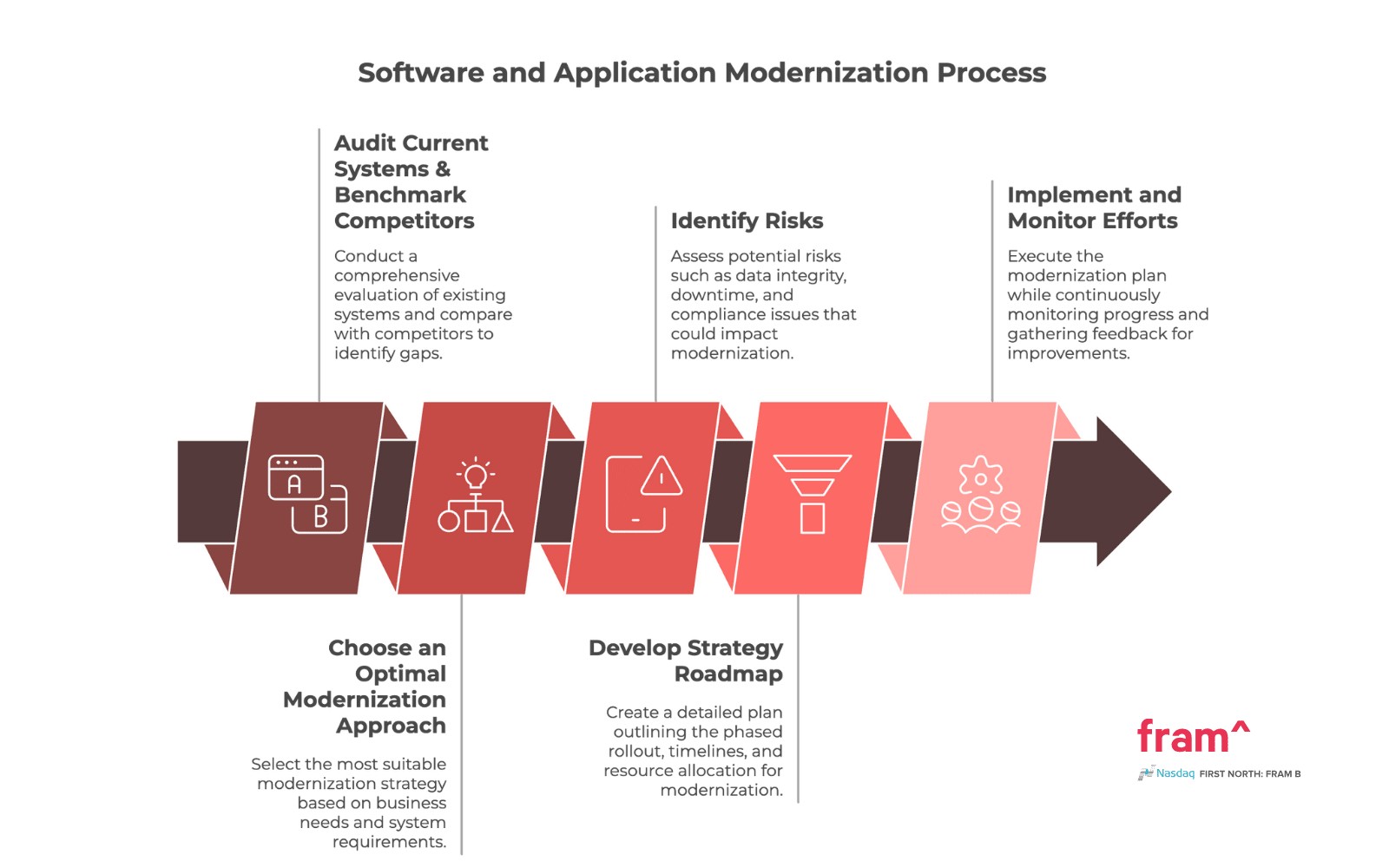Uncategorized
Essential Steps for Software Modernization With Case Studies
Software modernization transforms legacy systems to align with modern technology and business goals. More than an upgrade, modernization ensures scalable, secure systems that enhance customer experience.
This guide explores the importance of legacy system modernization, its benefits, challenges, and the essential steps you should take to do it right!

What is Software Modernization, and Why Do Legacy Systems Need It?
Software modernization refers to updating or rebuilding legacy systems to integrate advanced technologies and modern architectures. Legacy systems, often built with outdated technologies, pose challenges such as increased maintenance costs, security vulnerabilities, and lack of scalability.
Main Drivers of Modernization
- Technological Advancements: Rapid innovation in software technologies necessitates keeping systems current.
- Market Demands: Changing market dynamics and consumer expectations push businesses toward modernization.
- Compliance Requirements: Regulatory changes often require businesses to upgrade systems to ensure compliance.
- Cost Efficiency: Outdated systems are more expensive to maintain and operate.
- Security Concerns: Legacy systems are often vulnerable to modern cybersecurity threats.
Key Business Benefits of Software Modernization
Modernizing legacy technology isn’t just about keeping up with the latest trends—it’s a strategic investment that can transform how businesses operate, compete, and grow. Here are the major benefits:
- Performance – Modernized systems process data faster and scale efficiently. For example, an e-commerce company reduced checkout time from 10s to 2s, boosting conversion rates.
- Cost Efficiency – Reduces maintenance expenses, hardware costs, and IT overhead. A manufacturing firm saved 40% on infrastructure after migrating to the cloud.
- Competitiveness – Enables rapid product updates and faster go-to-market strategies. A SaaS company using microservices launched new pricing plans in weeks instead of months.
- Security – Strengthens protection with encryption, MFA, and compliance with industry standards like FIPS 140-2. Upgrading legacy systems significantly reduces breach risks and ensures regulatory compliance.
- Scalability – Cloud and modular architectures support growing user bases & data loads without performance degradation.
- Business Agility – Microservices and containerization allow faster updates, reducing downtime and improving development efficiency.
- Customer Experience – Improves UX with faster load times, intuitive interfaces, and seamless interactions, leading to better retention and revenue growth.

Real-World Software Modernization Examples
Software modernization is happening across industries, transforming how businesses and organizations operate. Here are some notable examples:
Insurance: Liberty Mutual’s Cloud Transformation
Liberty Mutual migrated from on-premises systems to AWS to modernize operations and drive company-wide transformation. This strategic move led to a 20% reduction in projected cloud costs over four years, achieved through effective FinOps strategies. Additionally, by building modern applications such as a serverless call center on AWS, Liberty Mutual reduced claim processing times to as little as 4 minutes, significantly enhancing customer satisfaction. (Read the full case study here)
Banking: Capital One’s Data Center Migration
Capital One closed eight on-premises data centers by migrating to AWS, becoming the first U.S. bank to announce going all-in on the cloud. This transition enabled the bank to scale its technology team to 11,000 members during the eight-year migration journey, fostering innovation and improving customer experiences. Furthermore, the cloud-first strategy allowed for instantly provisioned infrastructure at a near-unlimited scale, leading to lower costs and increased resiliency. (Read the full case study here)
Aviation: Southwest Airlines’ Reservation System Upgrade
Southwest Airlines transitioned to the Amadeus Altéa reservation system, aiming to generate approximately $500 million in incremental annual earnings before interest and taxes by 2020. This upgrade provided new features, including flight schedule optimization, and enhancing operational capabilities. (Read the full case study here).
Government: UK Home Office’s Cloud Cost Optimization
The UK’s Home Office Immigration Technology department reduced its overall cloud costs by 40% through various optimization techniques across storage and resources. This initiative demonstrates effective digital transformation within government operations. (Read the full case study here)
Overcoming Legacy Modernization Challenges
Modernizing legacy systems is not without its difficulties. These challenges can range from technical limitations to organizational hurdles, often requiring careful planning and mitigation strategies. Here are some of the most common challenges:
Technical Debt
Legacy systems often carry years of accumulated inefficiencies, outdated code, and workarounds. This “technical debt” increases the complexity of modernization efforts and may require significant time to untangle.
Future-proofing
Given the rapid pace of technological advancements, ensuring that modernized systems remain relevant in the long term is difficult. Businesses must make strategic choices about architecture, tools, and platforms to avoid another round of updates in a few years.
Fram^ tackled technical debt for a healthcare client by refactoring and consolidating fragmented code in their patient management system. This streamlined the codebase, reduced system errors, and prepared the platform for seamless integration with modern technologies, ensuring long-term scalability and maintainability.
Security Concerns
Transitioning from an outdated system introduces vulnerabilities during the migration process. If proper measures aren’t in place, data breaches or leaks could occur.
Our team prioritizes security during modernization projects. For instance, During a retail platform upgrade, we ensured security with encryption and penetration testing, protecting sensitive data and maintaining compliance with industry regulations.
Organizational Resistance
Modernization often involves significant change, and employees accustomed to older systems may resist adopting new technologies. Stakeholder buy-in and training are critical to overcome this barrier.
Fram^ addressed organizational resistance while modernizing a client’s inventory management system. By involving stakeholders early, offering tailored training programs, and demonstrating the benefits of the new system, we ensured a smooth transition. This approach not only reduced pushback but also boosted employee confidence in using the updated tools effectively.
Budget Constraints
Modernization projects can require a significant upfront investment. Balancing costs while maintaining day-to-day business operations can be challenging, especially for those with limited IT resources.
Fram^ helped a mid-sized retail client modernize their point-of-sale system within a constrained budget. By prioritizing high-impact updates and leveraging cost-effective cloud solutions, we minimized upfront expenses while ensuring a phased implementation. This strategy allowed the client to modernize operations without disrupting their workflow or exceeding their financial limits.
Choosing Between Cloud Migration and Mainframe
Businesses modernizing legacy systems can choose between:
|
Approach |
Pros |
Cons |
|
Cloud Migration |
Scalable, cost-efficient, flexible |
Complex data transfer, security adjustments needed |
|
Mainframe Modernization |
Enhances performance, maintains workflows |
Higher costs, limited scalability |
The right choice depends on your budget, business needs, and long-term growth plans.
Essential Steps in The Software and Application Modernization Process
A successful modernization process requires careful planning, clear objectives, and a systematic approach. Each step plays a critical role in ensuring the transformation aligns with business goals while minimizing risks.

Audit Current Systems & Benchmark Competitors
The first step is a comprehensive evaluation of your existing systems to identify inefficiencies, bottlenecks, and areas for improvement; as well as benchmarking your systems against competitors can reveal performance gaps and highlight areas for differentiation This step includes:
- Inventory Assessment: Catalog all software components, technologies, and dependencies.
- Performance Analysis: Measure system performance under different workloads to pinpoint slow or underperforming elements.
- Technical Debt Review: Identify outdated code, unsupported tools, or redundant processes that need attention.
- Stakeholder Input: Gather feedback from users and stakeholders to understand pain points and prioritize needs.
- Feature Analysis: Identify features competitors offer that your system lacks.
- Performance Metrics: Compare response times, user experiences, and scalability.
- Technological Trends: Analyze emerging technologies competitors have adopted and assess their relevance to your needs.
Outcome: Clear benchmarks for what your modernized system should achieve and a detailed report that serves as a baseline for modernization goals.
Choose an Optimal Modernization Approach For Your Needs
Modernization isn’t a one-size-fits-all process. Selecting the right approach depends on your business objectives, budget, and system requirements. Common approaches include:
|
Approach |
Time |
Cost |
Benefits |
|
Rehosting |
Quick |
Cost-effective |
Reduced risk, improved stability, however, performance is not optimized |
|
Replatforming |
Moderate |
Medium |
Improved efficiency with minimal refactoring |
|
Refactoring |
Long |
High |
Better scalability, performance, and maintainability |
|
Rebuilding |
Longest |
Highest |
Maximum flexibility, future-proofed system |
Outcome: A tailored approach that balances cost, risk, and long-term benefits.
Identify any Risks to your Software Modernization Strategy
Modernization projects often involve significant risks that must be mitigated proactively. Key considerations include:
- Data Integrity: Ensure no data is lost or corrupted during migration.
- Downtime Minimization: Plan to avoid disruptions to daily operations.
- Budget Overruns: Identify potential areas of unexpected costs.
- Compliance: Ensure the modernization plan adheres to relevant industry regulations.
Outcome: A risk mitigation plan to address potential challenges.
Develop an In-Depth Strategy Roadmap
A clear roadmap provides direction and helps align all stakeholders on project goals. Key components include:
- Phased Rollout Plan: Break the project into smaller, manageable phases to reduce complexity.
- Timelines and Milestones: Define key dates for each phase and measure progress.
- Resource Allocation: Assign roles and responsibilities across teams.
- Budget Plan: Allocate funding to each phase and monitor spending.
Outcome: A structured plan that ensures accountability and keeps the project on track.
Implement and Monitor the Modernization Efforts
Execution is where the plans come to life, and careful monitoring ensures success. Steps include:
- Pilot Testing: Launch a small-scale version to validate assumptions and adjust strategies.
- Incremental Implementation: Deploy updates in stages to minimize disruption.
- Performance Tracking: Use KPIs to measure the success of the implementation.
- Feedback Loop: Continuously gather user feedback to refine and improve the system.
Outcome: A modernized system that meets or exceeds the defined goals.
At fram^, we modernize systems using cloud-native platforms, microservices, and DevOps. These technologies enhance scalability, flexibility, and enable continuous improvements, ensuring long-term efficiency.
- Cloud-native platforms allow for seamless integration with existing infrastructure, ensuring high availability and minimal downtime.
- Microservices enable the system to be broken down into smaller, more manageable components, allowing for faster updates and a more agile development process.
- Additionally, DevOps practices enhance collaboration between development and operations teams, ensuring a smooth deployment and faster time to market.
Fram^ helped Retailer Company modernize their legacy order management system, which was slow and error-prone, especially during peak traffic. We migrated the system to a cloud-native infrastructure for scalability, implemented microservices for flexibility, and integrated real-time data synchronization for accurate inventory management.
As a result, checkout times were reduced by 50%, and inventory accuracy improved by 40%, leading to fewer cancellations and an overall better customer experience.
How To Ensure Software Modernization Efforts Are Successful?
To ensure your software modernization efforts are successful, follow these key strategies:
- Engage Stakeholders Early: Align goals and expectations with all parties involved.
- Invest in Training: Equip your development team with skills for modern technologies.
- Partner with Experts: At fram^, we specialize in creating scalable, secure modernization solutions tailored to your business needs.
- Implement Incrementally: Avoid disruptions by rolling out changes gradually.
With our expertise at fram^, we guide you through each of these steps to ensure your software modernization is not only successful but also delivers long-term business value.
FAQ on Modernization in Software Development
Here are some answers to frequently asked questions regarding software modernization.
How To Know When a Software System Needs Modernization?
Look for signs such as frequent downtime, high maintenance costs, and security vulnerabilities.
At fram^, we help businesses recognize when their software systems are due for modernization by looking for key indicators such as frequent downtime, high maintenance costs, and security vulnerabilities. For example, we assisted a retail client whose legacy order processing system was causing significant slowdowns during peak seasons. The system’s frequent crashes and inability to scale led to costly downtime and frustrated customers. By modernizing their infrastructure, we helped them improve system reliability, reduce maintenance costs, and enhance security. With our expertise, we ensure that your software is always up-to-date, resilient, and ready to support your business growth.
How Long Does Software Modernization Take?
Timelines vary depending on the modernization project’s complexity and unique needs, ranging from weeks to months.
At fram^, we understand that the timeline for software modernization varies based on the complexity of the project and the unique needs of your business. For instance, we recently worked with a financial services provider to modernize their aging transaction processing system. The process took several months due to the intricate integration with existing systems and the need for robust security measures. However, the result was a more efficient, scalable platform with improved transaction speed and security. We tailor each modernization effort to your specific requirements, ensuring that the project is completed within a timeframe that aligns with your business goals and minimizes disruption.
What Role Does Cloud Infrastructure Play Modernization?
Cloud platforms provide scalability, cost efficiency, and faster deployment options, making them integral to many modernization strategies.
Fram^ leverages cloud platforms to enhance scalability, cost efficiency, and deployment speed in modernization projects.
For example, we helped a logistics company transition its legacy system to a cloud-based solution, enabling real-time tracking and faster processing times. By moving to the cloud, they reduced infrastructure costs and improved overall system performance, making it easier to scale as their business grew. Cloud infrastructure is a crucial component in ensuring your systems are adaptable and future-proof.
Want fram^ to Help With Your Software Modernization?
At fram^, we use cutting-edge technologies like cloud platforms, microservices, and containerization for legacy software modernization because they offer scalability, flexibility, and enhanced security. Our expertise ensures a seamless, efficient transformation that aligns with your unique business needs. Ready to future-proof your software? Let’s talk!


